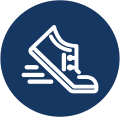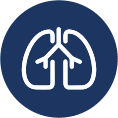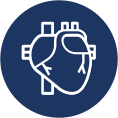DMD is the most common and most severe form of muscular dystrophy.
People with DMD can’t make a special protein called dystrophin, which acts as a shock absorber or stabilizer for muscles. Without dystrophin, muscle cells are easily damaged.
If the body does not have enough dystrophin, muscles become more sensitive to damage and deteriorate over time.
The injured muscles are gradually replaced with fat and scar tissue.
The lack of dystrophin and resulting loss of muscle lead to the symptoms of DMD.
Over time, the damage to muscles causes problems with movements such as getting up from the floor and walking.
DMD can occur in all muscles of the body–including muscles in the arms and legs, as well as the heart muscle and those involved in breathing. This can lead to problems with:

Walking

Breathing

Heartbeat

Eating
DMD leads to early death. While there is no cure for DMD at the present time, people with DMD are living longer than ever before. With the right care, people with DMD may live into their 30s and beyond.
While the progression and severity of DMD symptoms differ for every individual, most will experience some of the stages shown in the graphic.
DMD is caused by changes (mutations) in a certain gene, which in turn change the way the body works, leading to DMD.
Genes are made up of DNA, a code that tells the cells in our body how to make the building blocks of our bodies—called proteins. Proteins are needed to make and replace cells.
In DMD, there is a change (called a mutation) in the gene that tells the body to make dystrophin, a protective protein that’s necessary to keep the muscles working properly. Because of the change, the body stops making dystrophin, and without dystrophin, muscle cells are easily damaged.
Most cases of DMD are caused when large pieces of the dystrophin gene are lost or erased (‘deletions’). Less often, large pieces of the dystrophin gene are copied or duplicated (‘duplications’). DMD can also be caused by other, smaller changes in the DNA code.
Although most therapeutic strategies can be used regardless of the genetic mutation, in some cases treatment specifically for a particular mutation may be available.
The mutation in the gene that codes for dystrophin can
be either:
Spontaneous mutations can occur without any family history of the disease. These new mutations could then be passed onto the next generation. Most DMD cases are from inherited mutations, as shown in the graphic:
The gene that causes DMD is located on the X chromosome—and this means that boys are at greater risk of inheriting the disease. This is because boys don’t get a “backup copy” of the gene.

A girl will only develop DMD if both of her X chromosomes have faulty dystrophin genes. Girls affected by DMD normally have less severe symptoms than boys, but they may need the same treatment and care.
You can see the how the genetics work in this graphic:
This is because an affected father only passes a Y chromosome to his sons, and the DMD-causing gene is located on the X chromosome. However, he will pass the DMD-causing gene onto his daughters because each daughter inherits her father’s X chromosome. These daughters will be carriers.
If a woman is a DMD carrier, she may have another baby with DMD.
The chances of a carrier having a child with DMD are 1 in 4 (or 25%). This means that for every baby she has, there is a 1 in 4 chance that the child will have DMD.
In all carriers, regular strength check-ups and close heart monitoring are important to make sure that any symptoms that may arise are properly treated. This is why it is so important for female relatives of a boy with DMD to get tested to find out whether or not they are carriers.
*Carriers may show signs and symptoms of DMD and may need treatment. Adapted from the Muscular Dystrophy Association.

Amato AA, Brown RH Jr. Muscular dystrophies and other muscle diseases. In: Longo DL, et al., eds. Harrison’s Principles of Internal Medicine. 19th edition.
Birnkrant DJ, et al. Lancet Neurol. 2018;17:251-267 [Part 1].
Bushby K, et al. Lancet Neurol. 2010;9:77-93.
Dowling JJ, et al. Am J Med Genet. 2018;176:804–841.
Goemans N, et al. Eur Neurol Rev. 2014;9:78-82.
Houang EM, et al. Skelet Muscle. 2018;8(1):31.
Duchenne muscular dystrophy (DMD). Muscular Dystrophy Association. https://www.mda.org/disease/duchenne-muscular-dystrophy/research. Accessed March 2021.
What is DMD? Muscular Dystrophy Association.
https://www.mda.org/sites/default/files/2019/11/MDA_DMD_Fact_Sheet_Nov_2019.pdf. Accessed March 2021.
What is DMD? Muscular Dystrophy Association. https://www.ninds.nih.gov/Disorders/” Patient-Caregiver-Education/Hope-Through-Research/Musclar-Dystrophy-Hope-Through-Research. Accessed March 2021.
Noritz GH, et al. Pediatrics. 2013;131:e2016-e2027. van Ruiten HJA, et al. Arch Dis Child. 2014;99:1074-1077.
Birnkrant DJ, et al. Lancet Neurol. 2018;17:251–267 [Part 1].
Dowling JJ, et al. Am J Med Genet. 2018;176:804–841.
Flotats-Bastardas, Hahn A. Front Pediatr. 2020;8:583877.
Goemans N, et al. Eur Neurol Rev. 2014;9:78–82.
Lurio JG, et al. Am Fam Physician. 2015;91:38–44.
About muscular dystrophy (DMD). National Institutes of Health. https://www.nichd.nih.gov/health/topics/musculardys/conditioninfo. Accessed March 2021.
Noritz GH, et al. Pediatrics.2013;131:e2016–e2027.
van Ruiten HJA, et al. Arch Dis Child. 2014;99:1074–1077.
Birnkrant DJ, et al. Lancet Neurol. 2018;17:251–267 [Part 1].
How is DMD caused in girls? Duchenne UK. https://www.duchenneuk.org/faqs/girls-with-duchenne. Accessed March 2021.
How is DMD caused in girls? Duchenne UK. https://www.mda.org/disease/duchenne-muscular-dystrophy/causes-inheritance. Accessed March 2021.
Birnkrant DJ, et al. Lancet Neurol. 2018;17:251–267 [Part 1].
Birnkrant DJ, et al. Lancet Neurol. 2018;17:347–361 [Part 2].
Birnkrant DJ, et al. Lancet Neurol. 2018;17:445–455 [Part 3].
Muscular Dystrophy UK. Care advisors and clinical nurse specialists. Available at http://www.musculardystrophyuk.org/get-the-right-care-and-support/people-and-places-to-help-you/professionals-and-organisations/care-advisors/ [last accessed March 2021].
Amato AA, Brown RH Jr. Muscular dystrophies and other muscle diseases. In: Longo DL, et al., eds. Harrison’s Principles of Internal Medicine. 19th edition.
Birnkrant DJ, et al. Lancet Neurol. 2018;17:251-267 [Part 1].
Bushby K, et al. Lancet Neurol. 2010;9:77-93.
Dowling JJ, et al. Am J Med Genet. 2018;176:804–841.
Goemans N, et al. Eur Neurol Rev. 2014;9:78-82.
Houang EM, et al. Skelet Muscle. 2018;8(1):31.
Duchenne muscular dystrophy (DMD). Muscular Dystrophy Association. https://www.mda.org/disease/duchenne-muscular-dystrophy/research. Accessed March 2021.
What is DMD? Muscular Dystrophy Association.
https://www.mda.org/sites/default/files/2019/11/MDA_DMD_Fact_Sheet_Nov_2019.pdf. Accessed March 2021.
What is DMD? Muscular Dystrophy Association. https://www.ninds.nih.gov/Disorders/” Patient-Caregiver-Education/Hope-Through-Research/Musclar-Dystrophy-Hope-Through-Research. Accessed March 2021.
Noritz GH, et al. Pediatrics. 2013;131:e2016-e2027. van Ruiten HJA, et al. Arch Dis Child. 2014;99:1074-1077.
Birnkrant DJ, et al. Lancet Neurol. 2018;17:251–267 [Part 1].
Dowling JJ, et al. Am J Med Genet. 2018;176:804–841.
Flotats-Bastardas, Hahn A. Front Pediatr. 2020;8:583877.
Goemans N, et al. Eur Neurol Rev. 2014;9:78–82.
Lurio JG, et al. Am Fam Physician. 2015;91:38–44.
About muscular dystrophy (DMD). National Institutes of Health. https://www.nichd.nih.gov/health/topics/musculardys/conditioninfo. Accessed March 2021.
Noritz GH, et al. Pediatrics.2013;131:e2016–e2027.
van Ruiten HJA, et al. Arch Dis Child. 2014;99:1074–1077.
Birnkrant DJ, et al. Lancet Neurol. 2018;17:251–267 [Part 1].
How is DMD caused in girls? Duchenne UK. https://www.duchenneuk.org/faqs/girls-with-duchenne. Accessed March 2021.
How is DMD caused in girls? Duchenne UK. https://www.mda.org/disease/duchenne-muscular-dystrophy/causes-inheritance. Accessed March 2021.
You are about to view a website that PTC Therapeutics has not reviewed for accuracy, relevance or completeness.
PTC Therapeutics does not endorse organizations that sponsor linked external websites, products, or services that such organizations may offer; and does not control or guarantee the currency, accuracy, relevance or completeness of the information found on the linked external sites.
All trademarks includes herein are the property of their respective owners.
Neuromuscular disorders affect the muscles and nerves, and most of the causes are genetic. This means they are either passed down through the family or caused by changes in an individual person’s genes.
Most neuromuscular disorders cause muscle weakness that worsens over time. Signs and symptoms of neuromuscular diseases can vary and may be mild, moderate, or severe.
Most often, when a child has a neuromuscular disease, they don’t grow and develop as fast as other children their age. They are often slow to start lifting their head, sitting, walking, and talking.
Treatment and supportive care may improve the symptoms of a neuromuscular disorder, increasing mobility and even life expectancy.
Muscular dystrophy is the term for a group of neuromuscular disorders that cause muscle weakness and muscle loss.
Duchenne muscular dystrophy (DMD) is a type of muscular dystrophy that causes muscle weakness that worsens over time. The progression and symptoms can vary from person to person.
Sign up to receive the latest information from the Duchenne muscular dystrophy community. Be the first to receive:
News alerts
Content updates
Latest resources
Ongoing support

This site is intended for US residents only.
The information on this site is not intended to make a diagnosis or to take the place of talking to a US health care professional.
PTC Cares™ is a trademark of PTC Therapeutics.
© 2022 PTC Therapeutics, Inc. All rights reserved.
Date of preparation: September 2022
MAT-CORP-0268